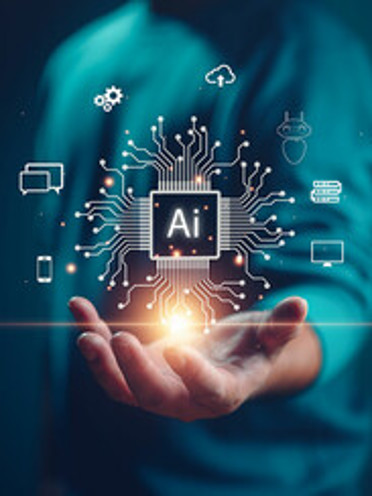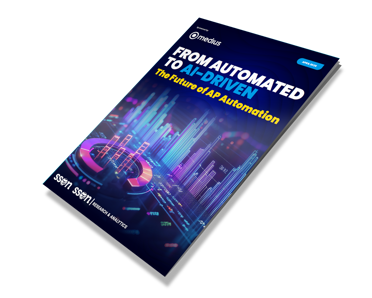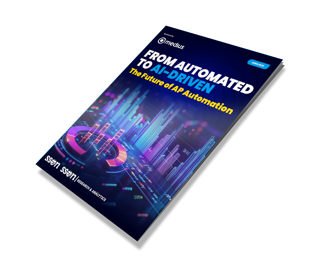Breaking down AI buzzwords in accounts payable
Turning the hype into tangible, valuable AP applications
Artificial Intelligence (AI) has evolved from a buzzword to a tech phenomenon, revolutionizing business operations and communications across the globe. Buzzwords like generative AI, Natural Language Processing (NLP), big data and more have surfaced within the AI category, making waves across headlines, internet searches and conference room discussions. But, the allure of "sexy" AI, such as ChatGPT, often overshadows the silent heroes quietly revolutionizing industries like Accounts Payable (AP).
AP thrives on efficiency and innovation –and AI functionalities are transforming the AP process in more ways than one. Let’s look at the true value AI can bring by breaking down the buzzwords, explaining what they mean and how they make a tangible impact in the trenches of AP and finance.
What does Artificial Intelligence (AI) mean?
First, let's define AI. If you Google it, you’ll find varying definitions that all have the same meaning. By definition, AI is the ability of a digital computer or computer-controlled robot to perform tasks commonly associated with human beings.
In business operations, AI includes a range of technologies that primarily focus on machine learning and deep learning. Its applications cover many areas, including data analytics, predictive modeling, object categorization, natural language processing, personalized recommendations, intelligent data retrieval and more.

Generative AI vs. predictive AI
Next, let’s discuss two approaches to AI gaining mindshare and ‘googling’ popularity.
- Generative AI:
Generative AI refers to systems that generate new content, such as images, text, or entire scenarios. For example, it can be used to create realistic images, write creative pieces of text, or even create new designs.
- Predictive AI:
Predictive AI is all about foreseeing future outcomes by crunching historical data. It uses statistical algorithms and machine learning models to analyze patterns and predict what will happen next. Application-wise, predictive AI is like a crystal ball for forecasting and making smart decisions based on past trends. It's widely used in finance, healthcare, and supply chain management to predict trends, risks and outcomes.
AI buzzwords for accounts payable
Now, let's talk about AP AI buzzwords and value. AI brings immense value to AP by automating processes, delivering immediate cost savings and improving strategy planning. It has the power to analyze vast amounts of data in real-time, leading to benefits, including:
- Efficiency and speed
- Reduced errors and improved accuracy
- Cost savings
- Enhanced data management
- Fraud prevention
- Improved decision-making
- Streamlined approval workflows
- Enhanced compliance
- Increased visibility and transparency
The need for AI in AP exists
According the a survey at the SSON AP Automation Virtual Summit in 2024, 56% of respondents labeled too much manual data entry as their yop challenge. A further 50% named invoice matching errors as their biggest burden. Without being able to leverage modern AI technology in their AP processes, organizations are leaving the door open to costly errors and increased administration costs.
Common AI buzzwords in accounts payable
What it means:
Accounts payable automation uses software and technology to automate processes related to AP, such as invoice processing, coding, payment disbursement and more.
Benefits:
Automating these processes ensures accuracy in paperwork and reduces time spent on manual tasks. Additionally, it allows for improved decision-making, streamlined approval workflows, enhanced compliance and increased visibility and transparency.
What it means:
Invoice automation uses AI and ML algorithms to transform the invoice processing workflow. It automates the capture, extraction and validation of invoice data, reducing the need for manual intervention.
Benefits:
Swift processing, reduced errors, and increased efficiency in handling invoices.
What it means:
Machine learning (ML) creates algorithms that enable systems to learn from data and improve performance over time. ML predicts invoice approval workflows in accounts payable (AP), identifies anomalies, and optimizes payment schedules through continuous learning.
Benefits:
Enhanced decision-making abilities, increased accuracy, and adaptation to evolving financial data patterns, including identifying anomalous patterns that may signal potential fraud.
What it means:
NLP allows the processing of written or spoken language to extract information and understand its meaning. In AP, NLP simplifies document review for important data points in invoices and contracts, aiding in reconciling invoice details with predefined rules.
Benefits:
Automated data extraction, improved accuracy and compliance with tax regulations and increased operational efficiency.
What it means:
Intelligent document processing (IDP) automatically extracts and classifies information from unstructured documents. In AP, IDP simplifies the data capture process by automatically scanning and categorizing invoices for payment approval decisions.
Benefits:
Streamlined invoice processing, improved decision accuracy and faster payment.
What it means:
Cognitive automation combines AI technologies like NLP and ML to empower systems to understand, interpret and respond to complex data and tasks. This can handle unstructured data in invoices, emails and other documents.
Benefits:
Streamlined processing of unstructured data, reduced manual effort, and increased accuracy in data interpretation for things like invoice matching.
What it means:
RPA utilizes software robots or "bots" to automate repetitive and rule-based tasks. In AP, RPA can automate routine processes such as data entry, invoice validation and payment processing.
Benefits:
Increased operational efficiency, decreased errors and cost savings through task automation.
What it means:
OCR technology converts various documents, including scanned paper, PDFs, or images, into editable and searchable data. In AP, OCR extracts information from invoices, receipts and other documents.
Benefits:
Improved accuracy in data extraction, reduced manual data entry, and accelerated processing of documents.
What it means:
Blockchain guarantees secure, transparent, and tamper-proof transactions. In accounts payable, blockchain creates a decentralized and distributed ledger to record and verify financial transactions, boosting trust and transparency in the payment process.
Benefits:
Enhanced security, reduced fraud, and increased visibility into transaction history.
What it means:
Predictive analytics uses fancy algorithms and ML to crunch historical data and predict the future. It can help forecast cash flow, spot possible late payments, and fine-tune payment strategies in accounts payable.
Benefits:
Improved financial planning, better cash flow management and proactive decision-making.
The real AP buzzword: Autonomous AP
Finally, let’s look at a buzzword you should know: autonomous AP. This one is important to note because it often gets confused with automation, but there is a distinct difference.
Traditional AP automation relies on humans for configuration maintenance. However, an autonomous solution powered by AI and Machine Learning (ML) can self-manage. This advanced technology enables seamless data compilation and invoice processing without human oversight, surpassing other automation systems in capability and efficiency.

A practical example:
Consider using simple rule-based automation to route an invoice to the proper approver on a project. It is still up to the approver to comb through dozens, sometimes hundreds of line items to verify that the proper data is present. This process is automated but not autonomous. Consider the same process using advanced AI/ML to match the invoice to the purchase order at the line-item level and further check the supplier credentials and past spending patterns to automatically approve this invoice for payment.
As SSON states, "AI will no longer be an option but a necessity for businesses seeking to maintain a competitive edge. Those who embrace AI-powered AP now will position themselves as industry leaders, setting new standards for financial excellence, operational agility, and data-driven decision-making."
There is much debate around new AI technologies and their impact on businesses. However, when it comes to accounts payable, the power of AI is undeniable. AI technology significantly streamlines AP processes for improved accuracy and efficiency while ensuring regulation compliance. Understanding where AI plays a significant role in the AP process and how it will shape the future of accounts payable is critical for business success and growth.
See why Medius leads the way in AP AI, creating the autonomous AP experience.
With AI and automation, Medius AP management software replaces the work and worry of invoices, so you can wrap up and rest easy.









